|
| |
| Sidebar:
Details on the Deck
Beam Layouts |
To lay out the shape of the curved deck beams
and cabin trunk overhead beams, I used a traditional layout process
described in several published sources on the subject, including Details
of Classic Boat Construction, by Larry Pardey. Using this source
as a basis, I worked out the curves using my own particular
dimensions. I followed the same process to create both the deck beam
curve and the cabin trunk curve, though the measurements in each case
differed. The steps and photographs below refer to my layout for the
cabin trunk beams. |
|
Step 1
I began with some basic marks.
After first establishing a level base line at the sheer height (edge of
the hull) and a centerline perpendicular to the sheer height, I
marked a new line 7" above, which represented the height of the side
of the cabin trunk at that point (above the sheer, not above the side
deck). Then, taking another measurement off my drawing, I marked the
center (and highest) point of the deck crown at 6" above the cabin
trunk sides. |
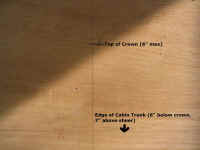
|
Step 2
Next, I set my compass to 6"--the
height of the maximum crown--and scribed an arc the left of the
centerline, running between the centerline and the baseline. The
centerpoint of the arc is the intersection between plumb centerline and
level baseline. |
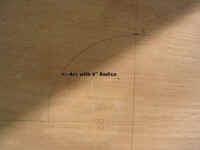 |
Step 3
I divided the base line into four
equal parts between the intersection of the arc and the centerline.
In this case, each mark was 1.5" apart (6"÷4). |
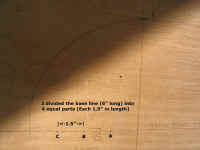 |
Step 4
Next, I divided the arc into four equal
parts. To do this, I had to dig through some old texts to refresh my
memory on how to proceed. To evenly divide any arc, set the dividers
to any random setting larger than half the radius (anything over 3"
in this case), and, with the point on first one and then the other of the
intersection points (12:00 or 9:00 in this case), swing an arc first one
way then the other, creating a specific point in space. When a
line is drawn through this point (B in the photo) and the centerline of
the arc (the intersection of plumb centerline and level baseline), the
intersection with the arc represents the halfway point of its length. |
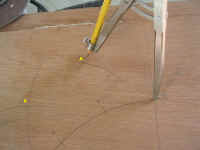 |
Step 5
After dividing the arc in half,
each half can be divided in half again by following the same process, only
moving the dividers as necessary whichever points are being used as the
basis of the division.
This photo shows me swinging the second
arc that forms point A in the photo above. I have the dividers set
on the centerline of the original and (point B) to create the second half
of the point. |
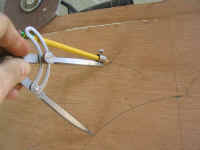 |
Step 6
When the points (A2, B2, C2) are marked
with the compass, connecting them with the baseline points (A1, B1, C1)
creates the evenly divided marks where they intersect the original arc
(A3, B3, C3).
Don't try to connect the points in this
photo, because there's a distortion resulting from the angle of the camera
in relation to the plane of the board. But they line up in real
life! |
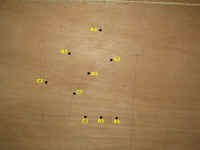 |
Step 7
The three points on the divided
arc--A3, B3, C3--represent the heights of the arc at three evenly-spaced
points along the baseline. To locate these heights, I first measured
the baseline (from the edge of the cabin trunk to the centerline) and
divided it into four equal parts, and marked these accordingly on the
baseline as shown. I drew perpendicular lines upward at each point. |
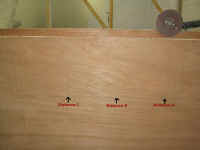 |
Step 8
Next, I transferred the heights
represented by the points A3, B3, and C3 in step 6 over to their
respective lines. You could measure the height and transfer it or,
as I did, simply use a level to transfer the marks across. |
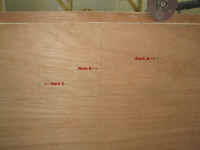 |
Step 9
With 9 total measured points (four on
each side plus the centerline), there was enough information to strike an
arc through all the points. I drove a small nail into each mark and
bent a springy batten across the nails, holding it tightly in place with
tape, and traced the line with a pencil. The arc in this photo looks
overly curvy on the centerline because, as I found out later, I had placed
the batten on the centerline above the mark, while the line was below the
marks at all other locations. I later made a minor adjustment to the
arc, which flattened the topmost portion accordingly, but it doesn't show
in this photo. |
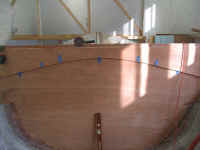 |
Completed
It may be hard to get a sense of
the character of the arc from the photos, but it looks smooth and good,
excepting the minor adjustment needed from step 9. |
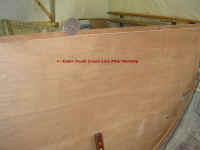 |
|
